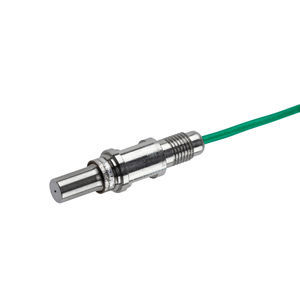
Absolute pressure sensor 4049Bpiezoresistivefor gasrugged

Add to favorites
Compare this product
Characteristics
- Pressure type
- absolute
- Technology
- piezoresistive
- Fluid
- for gas
- Protection level
- rugged
- Other characteristics
- compact, high-temperature, oil-filled, digitally compensated
- Pressure range
Max.: 10 bar
(145.04 psi)Min.: 0 bar
(0 psi)- Process temperature
Max.: 120 °C
(248 °F)Min.: 0 °C
(32 °F)
Description
The piezoresistive pressure sensors of Type 4049B with integrated water cooling are capable of continuous high-temperature operation. Available in absolute pressure ranges of 5 and 10 bar it is designed for use in various applications but specifically for exhaust pressure measurement without the use of additional water-cooled adapters. These pressure transducers use a Wheatstone bridge implanted in a silicon measuring element to generate an electrical signal, which is proportional to the applied pressure. The measuring element is situated in an oil-filled cavity seperated by a steel diapraghm. This core element is placed within a cooling jacket whereby the internal temperature can be suitably managed and is nearly independent of the applied hot gases. This approach allows the sensor to be exposed to gas temperatures in excess of 1100°C. Due to constant water cooling thermal effects are minimized. Therefore, the overall accuracy is improved. Further performance improvements are achieved using digital compensation, which reduces thermal effect to a minimum without sacrificing signal bandwidth. The digital compensation technique further allows monitoring of the sensor temperatures (with amplifiers of Types 4665B and 4624A).
Dynamical properties
Natural frequency
60 kHz
Catalogs
No catalogs are available for this product.
See all of Kistler‘s catalogsRelated Searches
- Pressure transmitter
- Analog pressure transmitter
- Pressure probe
- Membrane pressure transmitter
- Stainless steel pressure transmitter
- Analog pressure probe
- Sensitive element pressure transmitter
- Relative pressure probe
- Differential pressure transmitter
- Piezoresistive pressure transmitter
- Explosion-proof pressure transmitter
- Precision pressure transmitter
- Stainless steel pressure probe
- Sensitive element pressure sensor
- Threaded pressure sensor
- Absolute pressure sensor
- CE pressure transmitter
- Gas pressure sensor
- Waterproof pressure sensor
- Silicon pressure transmitter
*Prices are pre-tax. They exclude delivery charges and customs duties and do not include additional charges for installation or activation options. Prices are indicative only and may vary by country, with changes to the cost of raw materials and exchange rates.

















